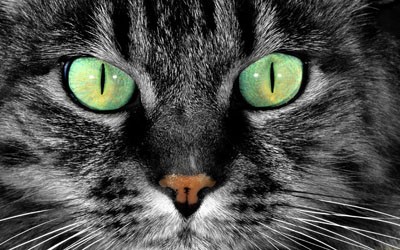Pupils Give Clues To Ecological Niche

By Merry Morris
Looking deeply into the eyes of your pet cat, one thing is immediately obvious. Assuming that your feline is easygoing and placid, doesn’t mind up-close-and-personal encounters with humans and is not struggling to get as far away as possible, you would be struck by its pupils. They are not like yours. They are not like a goat’s, either. As it turns out, that is all for the best.
Pupil Shapes Make A Difference
The pupils of various species vary markedly. Yours are round. Your cat has vertical pupils. The goat’s pupils show a distinctly horizontal orientation. Do all three of these eyes’ bearers see the world in the same way?
According to M.S. Banks and colleagues in a recent research article in Science Advances (AAAS), the shape of pupils confers different types of vision, which is closely related to their bearers’ survival.
Consider predators like your cat. Their pupils are vertically elongated with the characteristic slit. What natural advantage could this provide? According to Banks, that pupil shape gives very sharp vision of vertical objects over a great distance. For small ambush predators (again, like your cat), that vision is perfect for spotting their next victim. Now, how to catch it? They need to determine how far away the prey is and what direction it is moving. As opposed to the vertical acuity, their eye structures render horizontal objects fuzzy at closer ranges. Being able to process the fuzziness and clarity information makes it possible for the predator to triangulate distances as it lies in wait for the next meal.

Prey animals have very different needs. They must be able to guard against predator attacks from the ground. The cat’s vertical pupil would be inconsistent with the prey’s ecological niche, which often is grazing. Consider goats. Their horizontal, rectangular pupils afford them clarity in the horizontal direction, providing a panoramic view — much better to observe the predator on the horizon and determine which direction it is going. So critical is this perspective that when some grazing animals lower their heads to graze, they retain that panoramic view and their pupils remain horizontal by rotating upward by up to 50 degrees. The horizontal pupil may also shield the eye from intense overhead brightness, another plus for grazers.
This association of pupil shape and ecological niche doesn’t hold in all cases. Some predators, especially “taller” ones like tigers, lions and humans, have round pupils. Some scientists believe that many additional factors have gone into the evolution of the eyes. But how cool is it to imagine seeing the world as your cat?
Extension Questions
- Review all the structures of the eye
- In what other ways do the body types of predators and prey differ?
- What is man’s ecological niche?
